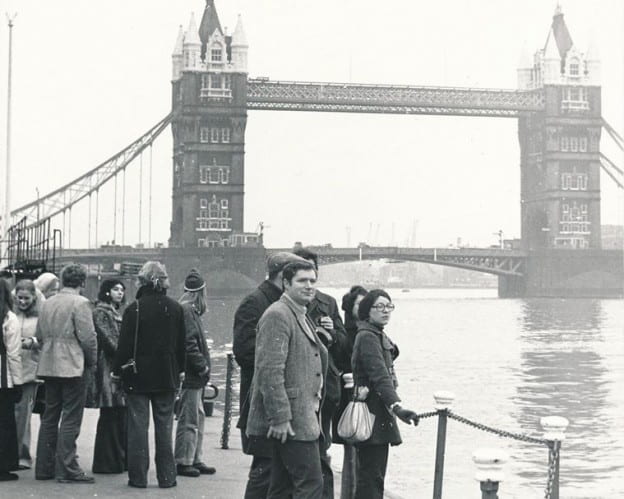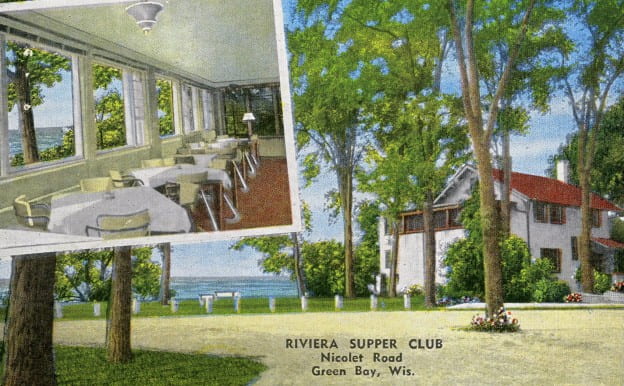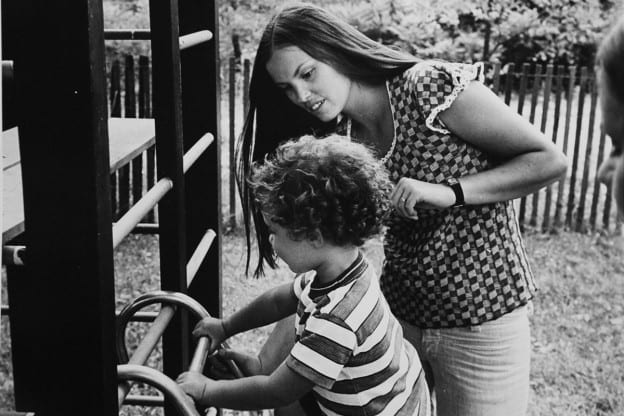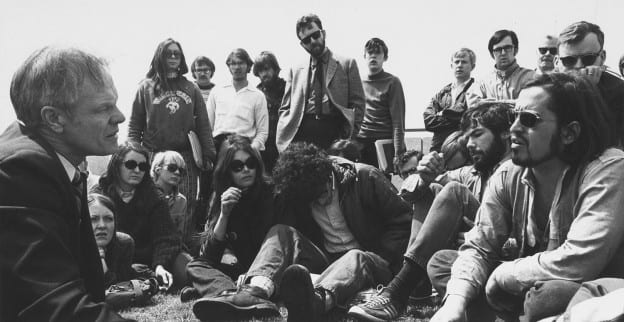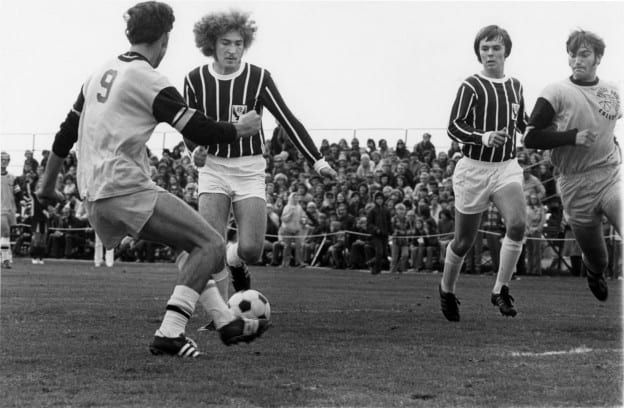A large contingent of UW-Green Bay students — more than 100 juniors and seniors — spent January 1970 in London with the new university’s first overseas study tour, the only trip that first year as a full-fledged four-year institution. Today, the Office of International Education informs us, approximately 15 travel courses depart throughout the year for destinations worldwide… still including London. (Incidentally, the photo above of a UWGB group near the iconic Tower Bridge over the Thames is believed to be from the 1974 trip.)
Corny fun
In 2005, a core group of UW-Green Bay alumni had to sort through sweet corn memories and bittersweet emotions following announcement that Bayfest 2005 would be the last. “The festival, and especially the corn tent, hold a lot of wonderful memories,” said Pam Stoll ’74 (at far left), former alumni president and longtime volunteer. “Working in the tent was the first thing I did as a returning alumnus.” Bayfest, held on the grounds of the University and featuring music, food and games, had a 25-year run under the direction of the late Tim Quigley as a primary fundraiser (an estimated $2.5 million total) for UWGB’s Division I athletics program. The UW-Green Bay Alumni Association staffed the corn tent for 13 years, selling close to 5,000 ears of corn annually to benefit student scholarships and alumni special events.
Early recycling
No, it wasn’t particularly sophisticated, convenient or photogenic, but this used-glass dropoff center near the Environmental Sciences Building was ahead-of-the-curve stuff circa 1970, the spring of the first Earth Day. UW-Green Bay was among the first local institutions to urge recycling. Within a year, indoor collection points on campus would supplant the bins, barrels and boxes shown here. The sign, labeled “This is the Glass Kitty,” encouraged users to donate only clean glass containers, with no rings or tops, and to separate by color. Point No. 4 said, “Thank you for your cooperation in helping save our environment.”
Riviera on the bay
The venerable Riviera Supper Club was a popular bayshore destination for Green Bay residents seeking fine dining in the mid-1900s. This vintage postcard touted the prime view and elegant dining rooms. (On the back of the postcard, it read: “The discriminating choose Riviera Supper Club, house of GOOD FOOD, PERSONALIZED SERVICE.” The menu advertised fresh lobster, broiled steaks, and chicken.) In the mid-1960s, when Brown County put together its offer of land to the University of Wisconsin as a building site for the new UW-Green Bay, the privately-held Riviera was one of the properties designated for purchase and transfer. The aging building was one of the first to be razed as the site was developed.
Sweet: Top 10 Women’s Basketball
The amazing UW-Green Bay women’s basketball program had its two greatest seasons earlier this decade. In March 2011, the Phoenix drove all the way to the Sweet 16. (That’s star forward Julie Wojta, above, driving against 6-8 Brittney Griner, the national player of the year. The Phoenix stayed close for a half before falling to No. 3 Baylor on the Bears’ home floor.) The following season, the Green Bay women finished 31-2 and ranked No. 10 in the final Associated Press Top 25 poll. As a senior, Wojta earned second-team All-America honors, placing her among the nation’s 10 best college players.
The Marching Band
In 1968, a year before the Shorewood Site opened, the Green Bay Packers organization made a major contribution to the fledgling university: a pledge of $24,000 to provide instruments and uniforms for a marching band. Conducted by Robert Bauer, the 130-piece band and color guard would later strut its stuff at Packers games at Lambeau Field and Milwaukee County Stadium. Interest eventually waned, and the band was no more within a decade, but the fact the college without its own football team once fielded a marching band remains a topic of interest among early alumni.
UW-Green Bay on the West Side?
In 1964, the early frontrunner for the new UWGB was a 400-acre site near the intersection of Highways 41 on 54 on Green Bay’s West Side. Known as “the Larsen orchard site,” it was eventually passed over for the scenic 700-acre bayshore location, known as the Shorewood Site because of the private golf course that occupied part of the area. Founding Chancellor Edward Weidner (at right, above) is shown here giving a tour of the Shorewood location to some of the members of his administrative team in fall 1967, a few weeks before groundbreaking for the first new buildings. With Weidner are, from left, Robert Maier, Ray Vlasin and Russ White.
Child care on campus
UW-Green Bay opened a childcare and human-development study facility in fall 1972 with 41 toddlers. Financed by student fees and gifts from the University League, an organization of campus and community women, the center found a home in a refurbished ranch house near the campus entrance. With annual operations running in the red, badly in need of repair and lagging behind modern design and code for contemporary child care facilities, the center closed in 1995. Student Government Association leaders and others have periodically encouraged the University to revisit the concept of an on-campus service. A consultant suggested a viable alternative might be to dedicate student fee support for contracting with privately run facilities nearby to hold slots open for student parents. Students who use such a service could be partially subsidized and reimbursed by way of a voucher system.
Peaceful protests, discussion
Two days after the May 1970 shootings at Kent State, about 2,000 local citizens including UWGB, St. Norbert and local high school students walked in a silent, candle-lit procession in downtown Green Bay, joined by mayor Donald Tilleman. Tilleman then visited campus later that week for a human rights and anti-war “Teach-In.” The UW-Green Bay students and faculty identified as talking with the mayor (who is at far left in this photo) included Sandra Vander Heiden (first row, second from left), John Henry (first row, far right), Tom Krueger (first row, second from far right), Professor Paul Abrahams (center with beard), Thomas Swoboda (next to Abrahams), Mike Morgan (second row, far right), Rollin Posey (second row, second from right) and Tim Brennan (second row, third from right).
Lombardi recommended soccer
UW-Green Bay plays soccer as its primary fall sport primarily on the advice of the late Vince Lombardi. The legendary Packers coach was an athletics adviser to Chancellor Edward Weidner in 1967-68 when the new university was charting its athletics future. Lombardi advised against college football because of its relatively high cost and the likelihood that the university team would be overshadowed by the Packers He also believed in soccer’s long-term growth potential and the prospects for UWGB success at the highest level of NCAA competition (which proved true).
